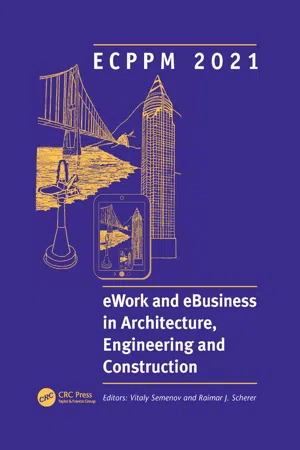1 Introduction
Building Information Modeling (BIM) is becoming more and more the state of the art in AEC projects. Software tools such as Autodesk Revit, Allplan or ArchiCAD are examples for modeling tools used in daily practice. Different kinds of information are specified; the most relevant kinds are semantics and geometry. Semantics are terms which classify components such as beam, slab, column, door or stairway including terms to name properties and values for properties. This paper focuses on geometry.
Software companies usually do not publish details of their implementations. This is true to data structures and algorithms. Contrary to this, theoretical approaches are published and taught at universities all over the world. The most frequently used theories are based on boundary representations (BRep) or Constructive Solid Geometry (CSG). In addition, the shape of components can be described by parameters (Mäntylä 1988).
Existing modeling tools map their internal data onto standardized models for data transfer between different software tools. The most frequently used standard are the Industry Foundation Classes (IFC) (IFC 2020a).
The IFC concept, its implementation and its widespread application have contributed very significantly to the benefits of BIM for AEC. Some of the initial expectations associated with the introduction of the concept did, however, not materialize. When IFC was first presented, one of the main targets was to achieve interoperability between the products of different vendors by standardization.
Unfortunately, this goal has not been achieved. In the place of interoperable systems of independent vendors, we observe acquisition and integration of specialized systems into large general purpose products. Interoperability is mainly limited to the product spectrum of each of the major vendors, complemented by selected strategic partnerships. The disadvantages of this situation are obvious. There may be important commercial reasons for the observed development, but the essential reasons lie much deeper in the IFC concept itself, as discussed below.
IFC are based on ISO standard 10303 and use the above mentioned theoretical approaches for boundary representation of shapes, constructive solid geometry or parametric modeling, treating topology as a property defined for specific shapes as standardized e.g. in the IfcTopologyResource (IFC 2020b).
The most important prerequisite for the interoperability of two systems in the field of geometry is the unhindered transfer of topology between the systems, because topology defines the neighborhood relations of their objects. It is not sufficient to transfer the internal topology of each individual object. A much more difficult task is the transfer of the topological relations between a large number of independent objects of many different classes with a wealth of shapes. The IFC concept does not handle the complexity of this problem adequately at present (Huhnt & Galishnikova 2018).
The authors of this paper are convinced that space partitioning can handle topology much more efficiently than component assembly. A main target of polyhedral space partitioning is to solve the topology aspect of the interoperability problem with a shape-free generalized topology treating all objects as one coherent topological system independent of standardization.
A fundamental feature of existing and broadly used approaches is the construction of models by assembly of individually constructed components. Considerable precautions must be taken to avoid collisions and unintended gaps between the objects of a model with serious consequences for the construction process. There is a fundamental difference between the assembly of components by positioning in space and defining objects by the partitioning of space itself. If an object is added to an existing set of objects, it must be tested against each of these objects to avoid collisions and gaps. Ingenious methods have been devised to reduce the scope and effort of this task, but the basic problem persists (Kraft 2014). If space is partitioned by splitting one object at a time, the checking can be restricted to the object that is being split. Very significant gains in simplicity, accuracy and efficiency are achieved.
Partitioning of space is not a new concept (Mäntylä 1988). Orthogonal space partitions with quadtrees and octrees are well known, as are binary space partitions with half-spaces utilizing BSP-trees. If it is sufficient to bound objects with bounding volumes, then axis-aligned bounding boxes AABB or oriented bounding boxes OBB and related concepts can be employed (Ottmann & Widmayer 2002). While these concepts have many important and successful applications, for example for collision detection in computer games, they are not suitable to describe explicitly the complex polyhedral character of buildings which are only in part rectangular and possess many concave and multiply connected spaces. Other concepts of partitioning have therefore been investigated specifically for constructed facilities.
This paper presents first studies by the authors of an alternate approach to space partitioning. The general introduction in section 1 is followed by a review of the state of the art in section 2 and a presentation in section 3 of alternate concepts which distinguish the approach of the authors from the state of the art approaches. Section 3.1 treats differences between partitions of bounded and unbounded space. Reasons for the separation of the partition model into a user and a core model are given in section 3.2. The user specification of a partition is presented in section 3.3, its automated mapping to the core model in section 3.4. Section 3.5 illustrates navigation in the partition model. In section 3.6 the basic model is expanded to models with enhanced semantics. The paper ends with conclusions and an outlook in section 4.
